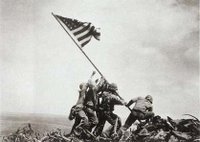Jams O’Donnell recently posted a well researched piece on the manipulation of perception via photography, particularly the ethical considerations of posed war photos by famous photographers, a notable example being the iconic ‘raising the flag on Iwo Jima’
The photograph has come to represent to us a short-cut to the facts, we believe what we see since it is reported to be true and the evidence is right there in front of us.
The photograph, through chemical process (more recently digital-electrical process) and manipulation of light through a hole is little more than modern man’s equivalent to cave painting.
What should be obvious to anyone who has ever taken a photograph is that fact that the camera offers a limited vision of reality.
There are a number of factors to remember:
Intrinsic in the act of pointing a camera is the limitation of framing. For example, most photographs of the Pyramids of Giza exclude the proximity of Giza’s encroaching buildings.
The camera should be viewed as a visual pen, especially when used to portray ‘news’. Just as words are manipulated to serve political/propaganda/poetic & literary ends, so too can pictures be manipulated by cropping; posing; filters and numerous other darkroom tricks.
The camera does not capture reality any more than Hollywood captures morality. A photograph is a two dimensional rendition of a four dimensional experience with all four dimensions being distorted in one way or another:
- Dimensions x (width) and y (height) are now limited to the size of the photograph or image on your screen.
- Dimension z (depth) is transposed into the realms of
illusion.
- Time (a dynamic dimension) becomes static.
With the advent of ever higher quality digital cameras and photo editing software, we, the amateurs, with a little practice, can now achieve what before could only be achieved in the darkroom by professionals. Cropping; lighting and masking, we can now manipulate with the best of them.
When preparing my recent ‘View From The Treetops’ post I excluded everything bad about the town where I live – no houses or people, with the exception of a snippet of philosophical graffiti, only green landscape.
Those who viewed/commented on the post were misled into believing that my walk constituted lush greenery, solitude and quiet.
Let the following go some way to balance that particular manipulation.













5 comments:
A captured mind, like the camera lens. I liked you walking out in deserted nature. But still, your walk looks interesting, from the next frames.
It is strange how one can take a photo of the familiar, then on looking at it hardly recognize it. The view squared off.
I liked "God will see you at the times shown" (snort).
Thanks for the review - yes, we do seem to travel in some of the same circles! Stay in touch, then - it's synchronicity. Perhaps our tribes overlap in multiple ways.
I naively thought, now that anyone could photoshop (fake)any picture imaginable, photos would be seen to be information only, no longer be mistaken for the object in the picture. Wrong! Some people still look at Magritte's painting of a pipe, read the disclaimer and still think they've been looking at a pipe. The same people still see the US government as they believe governments should be and not as almost anything coming out of the White House proves to be wrong.
Pisces The photogaph is every bit a subjective medium as any other. it is no different to the portrait in that respect.
As you show with your photos, as I do with mine and so on we portray our own versions of reality. I don't pretend to be much of a photographer but the simple act of focusing on a small detail can change how a situation is interpreted. You don't need Photoshop; you certainly don't need, for example, the darkroom skills that the Soviets used so ridiculously to doctor images!
Oh I forgot to add, you have some nice pics here!
Post a Comment